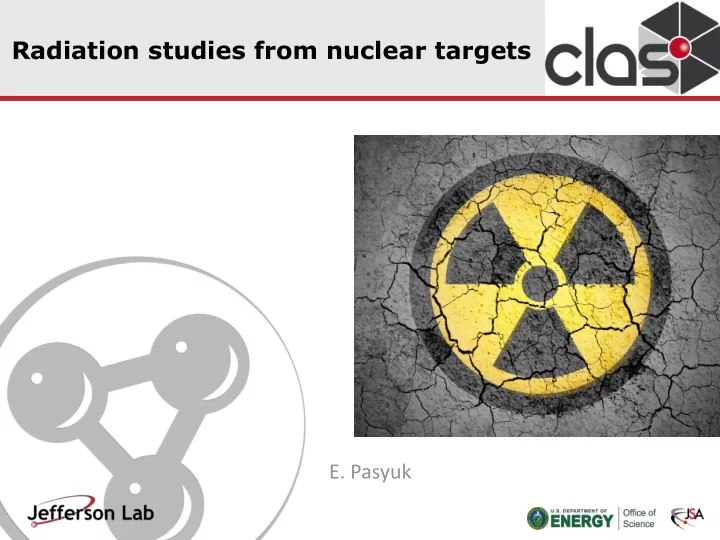

Radiation studies from nuclear targets E. Pasyuk
Test goals • Validate simulations by measuring radiation dose at various locations around the target • Measure occupancies and the leakage currents in the silicon sensors • Measure rates and occupancies in all CLAS12 detectors Nuclear target test run wiki: https://clasweb.jlab.org/wiki/index.php/Nuclear_target_test E. Pasyuk CLAS Collaboration meeting November 12-15, 2019 2
SVT Modules on Scattering Chamber Scattering Chamber SVT Module Solid or Liquid Target Cold Plate Beam E. Pasyuk CLAS Collaboration meeting November 12-15, 2019 3
Dosimetry Our regular dosimeters • Photons (X and gamma rays) with energies between 5 keV to 20MeV with a detection range of 5 mrem to 1000 rem. • Beta particles with energies greater than 150 keV(expressed as average energy) with a detection range of 20 mrem to 1000 rem. • Fast neutrons with CR-39: 40 keV to 40 MeV with a detection range of 20 mrem to25rem. • Thermalized neutrons with CR-39: less than .5 KeV with a minimal detection range of 10 mrem to a maximal detection range of 5 rem. • Cost $40/piece. Reading off-site. Turnaround time 10 days. E. Pasyuk CLAS Collaboration meeting November 12-15, 2019 4
Real time dose monitoring • BF 3 proportional counter with polyethylene moderator • B 10 +n->Li 7 +He 4 ,E>0.84 MeV • Power supply and front-end is provided by RadCon • DAQ: Connect to discriminator/scaler in EPICS • Mount two detectors on the target tube upstream of the solenoid • Another two on the corners of the CVT insertion cart • Install before RGB • After RGB install gamma monitor. Status: Design of mounts is underway and coordinated with magnet group. Cables ordered. We will use JLab discriminators and read to EPICS. E. Pasyuk CLAS Collaboration meeting November 12-15, 2019 5
Radiation monitors on CVT Cart Neutron counters Ion chamber E. Pasyuk CLAS Collaboration meeting November 12-15, 2019 6
Neutron activation analysis • Neutron induced reactions. Count decays of product nucleus. • RadCon used this technique in the past and they have equipment for counting •Indium foil is a reasonable choice Standard foils are 0.5-inch diameter E. Pasyuk CLAS Collaboration meeting November 12-15, 2019 7
Indium Neutron energy Reaction Half-life of product Cross section Thermal In 115 (n, 𝛿 )In 116m 54 min 170 barn 0.025 eV Intermediate In 115 (n, 𝛿 )In 116m 54 min 3243 barn 1.457 eV “fast” In 115 (n,n ’)In 115m 4.5 hour 170 mbarn 1.2 MeV • Use Cd covers to filter out thermal neutrons. Cd absorbs neutrons below 0.4 eV • Two foils: one bare, the other with Cd covers. • Irradiation time ~ 4- 5hours. For “fast” neutrons will get ~60% of maximum activity. For ”slow” neutrons close to maximum activity. E. Pasyuk CLAS Collaboration meeting November 12-15, 2019 8
Simulated neutron fluency 5 cm LD2 1 nA 1 hour E. Pasyuk CLAS Collaboration meeting November 12-15, 2019 9
Configuration • Beam energy 10+ GeV (and 4 GeV?) • Targets: LD2, LHe, Pb (0.125 mm), Sn (0.25 mm) • Torus polarity: electrons out bending • Solenoid full field • Trigger: Inclusive electron trigger • Standard CLAS configuration • Lower thresholds on CND (?) • CVT is removed and replaced by two Si sensors • Dosimetry • For each target we allocated up to 12 hours of beam including tuning E. Pasyuk CLAS Collaboration meeting November 12-15, 2019 10
Set of measurements for each target • luminosity scan - record rates of all detectors - record SVT currents and occupancy - DC occupancy • Take data. Beam current TBD after luminosity scan. Use CND to detect inclusive eA-> e’n • Install dosimeters and activation foils • Irradiate dosimeters and foils for 4-5 hours. Record beam current and exposure time. • Take out dosimeters and foils. • Pass foils to RadCon for counting E. Pasyuk CLAS Collaboration meeting November 12-15, 2019 11
Time estimate • For each target we allocated up to 16 hours • Transition LD2->LHe 8 hours • Transition LHe ->Pb 2 days • Transition Pb -> Sn 1 day E. Pasyuk CLAS Collaboration meeting November 12-15, 2019 12
Status and preparations • ERR - December 3 rd • Target is ready • Optimize Installation/measurement schedule • Design insertion/removal fixture for dosimeters and foils Write TOSP for this procedure • Fabricate SVT mount and dosimeter insertion system • Prepare RSAD an other paperwork for the run E. Pasyuk CLAS Collaboration meeting November 12-15, 2019 13
Recommend
More recommend